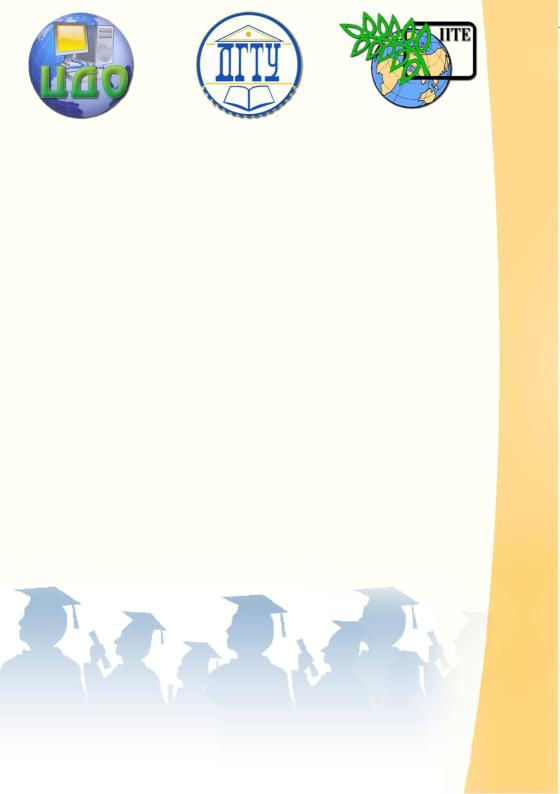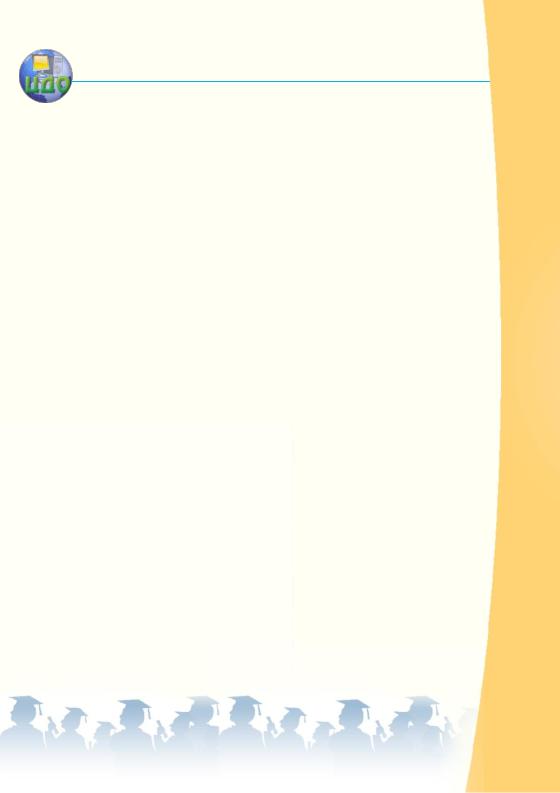
1448
.pdf
ДОНСКОЙ ГОСУДАРСТВЕННЫЙ ТЕХНИЧЕСКИЙ УНИВЕРСИТЕТ
УПРАВЛЕНИЕ ДИСТАНЦИОННОГО ОБУЧЕНИЯ И ПОВЫШЕНИЯ КВАЛИФИКАЦИИ
Кафедра «Научно-технический перевод и профессиональная коммуникация»
МЕТОДИЧЕСКИЕ УКАЗАНИЯ
для самостоятельной работы студентов технических специальностей, обучающихся по курсу
«Technology 1»
Составители Шаповалова Ю.В. Волкова Т.В. Панкова В.В.
Ростов-на-Дону, 2011

Управление дистанционного обучения и повышения квалификации
Английский язык
Аннотация
Данные методические указания созданы на базе действующей программы и могут быть использованы студентами любых технических специальностей для развития навыков чтения, перевода, говорения, аннотирования текстов технической направленности.
Составители
к.ф.н., доц. Шаповалова Ю.В.,
к.ф.н., доц. Волкова Т.В.,
к.филолог.н., доц. Панкова В.В.

Управление дистанционного обучения и повышения квалификации
Английский язык |
|
Оглавление |
|
Часть I ..................................................................................... |
4 |
Unit 1 Technology and Society ........................................... |
4 |
Unit II Studying technology ............................................... |
7 |
Часть II.................................................................................. |
10 |
Unit III Design ................................................................. |
10 |
Unit IV Technology in Sport .............................................. |
12 |
Часть III ................................................................................ |
15 |
Unit V APPROPRIATE TECHNOLOGY .................................. |
15 |
Unit VI Crime-fighting and security.................................... |
17 |
3

Управление дистанционного обучения и повышения квалификации
Английский язык
ЧАСТЬ I
Unit 1 Technology and Society
I. Add to your active vocabulary:
1. |
technology |
a) техника; технические и прикладные |
|
|
науки |
|
|
b) технология |
|
|
c) специальная терминология; методикa |
2. |
state-of-the-art |
самая современная технология |
technology |
|
|
3. |
application |
применение, использование, употребле- |
|
|
ние; приложение; применимость |
4. |
to improve |
улучшать; совершенствовать; налажи- |
|
|
вать |
5. |
to design |
a)проектировать; конструировать |
|
|
b) задумывать, разрабатывать; намере- |
|
|
ваться, собираться (сделать что-л.) |
6. |
to test |
a)подвергать испытанию, проверке; b) |
|
|
тестировать, проверять; производить |
|
|
опыты |
7. |
technician |
a) техник; |
|
|
b) человек, знающий свое дело; специа- |
|
|
лист |
|
|
c) лаборант |
8. |
technologist |
a) технолог; b) техник |
9. |
engineer |
инженер; конструктор; механик |
10. |
electrical engineer |
электротехник |
11. |
highway engineer |
дорожный инженер |
12. |
civil engineering |
а) искусство/техника строительства |
|
|
b) гражданское строительство |
13.mechanical engiмашиностроение neering
14.electrical engineerэлектротехника
ing
15. |
marine engineering |
кораблестроение |
16. |
fibre (fiber) optics |
волоконная оптика |
17. |
satellite |
искусственный спутник |
4

Управление дистанционного обучения и повышения квалификации
|
|
|
|
Английский язык |
18. |
debit card |
|
дебетная карта (карта, аналогичная |
|
|
||||
|
|
|
|
кредитной, все расходы по которой не- |
|
|
|
|
медленно перечисляются с соответству- |
|
|
|
|
ющего счета) |
19. |
ATM |
automatic |
|
банковский автомат, банкомат |
teller machine |
|
|
|
|
20. |
Business-to- |
|
взаимодействие "бизнес-бизнес", опера- |
|
business (B2B) |
|
ции между компаниями (сфера рыночных |
||
|
|
|
|
отношений, соответствующая трансакци- |
|
|
|
|
ям между юридическими лицами (компа- |
|
|
|
|
ниями) |
21. |
efficiency |
|
|
a)продуктивность, производительность; |
|
|
|
|
b)(техн.) отдача, коэффициент полезно- |
|
|
|
|
го действия |
22. |
power |
|
|
a) мощность; энергия; b) степень; пока- |
|
|
|
|
затель степени; c) способность; возмож- |
|
|
|
|
ность; d) (оптическое) увеличение; e) |
|
|
|
|
производительность |
23. |
medicine |
|
|
лекарство, медикамент, медицина |
24. |
sewerage |
|
|
a) канализация, канализационная си- |
|
|
|
|
стема b) сточные воды, нечистоты |
25. |
waste disposal |
|
a) удаление отходов; захоронение отхо- |
|
|
|
|
|
дов b) сброс (отведение) сточных вод |
26. |
manufacturing |
|
a) производство; изготовление b) обра- |
|
|
|
|
|
ботка |
27. |
robotics |
|
|
робототехника |
28. |
minerals |
|
|
полезные ископаемые |
29. |
challenge |
|
|
а) вызов б) сложная задача, проблема |
30. |
to eliminate |
|
a)устранять, исключать (from) b) уни- |
|
|
|
|
|
чтожать, ликвидировать, аннулировать |
|
|
|
|
c) игнорировать, не замечать, пренебре- |
|
|
|
|
гать |
II . Read and translate the text Technology and society:
The purpose of technology is to produce applications which improve our material environment. The people who design, test, and make these applications are called technicians, technologists, and engineers. They work in areas such as civil, mechanical, electrical, electronic, and marine engineering, and in newer fields such as information technology (IT). They use scientific knowledge and technological experience in their work. They often adapt older existing technol-
5

Управление дистанционного обучения и повышения квалификации
Английский язык
ogy (e.g. radio waves) to create new applications (e.g. mobile phones).
Technology is all around us and affects every aspect of our lives. Here are some examples:
•transport - road, sea, and air travel; space exploration.
•telecommunications - mobile phones, fibre-optics, internet, satellites.
•trade - credit and debit cards, bank ATM machines, Busi- ness-to-business (B2B) internet trade.
•work efficiency - washing machines, microwave ovens, computer software.
•power - heating, lighting, air conditioning.
•personal entertainment - DVDs, iPods, digital TVs, digital cameras.
•health - lasers in eye surgery, medicines.
•safety and security - ABS brakes, air bags, sensors, smoke detectors.
•food - food processing, agriculture.
•information management - computer databases, search engines, business software.
•infrastructure - roads, buildings, sewerage, waste disposal, water supply.
•manufacturing - robotics in mass production (manufacturing an item in very large numbers).
Because technology is so important in society, technicians, technologists, and engineers always have to think about values, that is, whether something is good or bad. Unfortunately, some technology has both positive and negative effects on society. Using minerals such as oil, coal, iron, and uranium improves our standard of living, but can also pollute the air, water, and ground. The same rockets that allow space exploration can carry nuclear weapons. Road vehicles and planes allow fast travel but also cause accidental deaths and create global warming. The challenge for technology is how to increase the positive effects on society but reduce or eliminate the negative effects.
6

Управление дистанционного обучения и повышения квалификации
Английский язык
Unit II Studying technology
I. Add to your active vocabulary:
31. |
level |
a)уровень; |
|
b)степень, |
ступень; |
|
|
|
c)плоская, горизонтальная поверхность |
||||
32. |
advanced |
a)современный, передовой; b)развитый; |
||||
|
|
отлаженный, отработанный |
||||
33. |
hold – held - held |
a)занимать (пост, должность и т. п.); |
||||
|
|
иметь (звание, ранг и т. п.); b)держать |
||||
|
|
содержать; хранить; c)владеть |
||||
34. |
university degree |
университетский диплом, степень |
||||
35. |
title |
звание; название |
|
|
||
36. interchangeably |
взаимозаменяемо |
|
|
|||
37. |
mean – meant - |
a)иметь |
в |
виду; |
b)намереваться; |
|
meant |
c)думать, подразумевать; d) значить, |
|||||
|
|
означать |
|
|
|
|
38. |
course at college |
курс (лекций, обучения) |
|
|
||
39. |
to offer |
предлагать |
|
|
|
|
40. to follow the route |
следовать маршруту |
|
|
|||
41. |
bachelor |
бакалавр |
|
|
|
|
42. |
to allow |
a)позволять, |
|
|
разрешать; |
|
|
|
b)предоставлять, давать возможность |
||||
43. |
to transfer |
переходить; переводиться |
|
|||
44. |
apprentice |
ученик; новичок |
|
|
||
45. |
to release from |
освобождать от |
|
|
|
|
46. |
construction |
сооружение, строительство |
||||
47. |
highway |
а)шоссе, магистраль; b)главная линия |
||||
|
|
связи, основной путь |
|
|
||
48. |
harbour |
гавань; порт |
|
|
|
|
49. |
syllabus |
программа обучения |
|
|
||
50. |
surveying |
обследование |
|
|
|
|
51. |
to measure |
измерять, мерить |
|
|
||
52. |
site |
место; стройплощадка; участок |
||||
53. |
to ensure |
a)гарантировать, |
|
обеспечивать; |
||
|
|
b)застраховать |
|
|
|
|
54. |
budget |
бюджет; финансовая смета |
||||
55. |
safely |
безопасно |
|
|
|
|
56. |
fluid mechanics |
гидромеханика |
|
|
|
|
57. |
liquid |
жидкость |
|
|
|
|
58. |
to affect |
иметь предрасположенность, тенденцию |
||||
|
|
7 |
|
|
|
|

Управление дистанционного обучения и повышения квалификации
|
|
|
Английский язык |
|
|
|
|
59. |
pipeline |
|
трубопровод, нефтепровод |
60. |
dam |
|
дамба, плотина, насыпь |
61. |
property |
|
a)свойство, качество; b)имущество; соб- |
|
|
|
ственность |
62. |
soil |
|
грунт, земля, почва |
63. |
rock |
|
a)горная порода; b)скала |
64. |
foundation |
фундамент, основание |
|
65. |
skills |
|
навыки |
66. |
matter |
|
тема, вопрос, предмет (обсуждения и т. |
|
|
|
п.) |
67. |
client |
|
a)клиент; b) подчиненный |
68. |
colleague |
коллега, сослуживец |
|
69. |
CAD |
(computer- |
автоматизированное проектирование |
aided design) |
|
||
70. |
surveyor |
|
землемер; топограф; геодезист |
71. |
architect |
|
архитектор |
II . Read and translate the text Studying technology:
What is the difference between a technician, a technologist, and an engineer? The main difference is in level of education and training. Engineers have the most advanced training and normally hold university degrees. In everyday contexts, the titles technician and technologist are sometimes used interchangeably, meaning a specialist working in technology below the level of engineer. In training contexts, technologist is normally used for someone at a higher level (usually trained for 2-3 years) than a technician (usually trained for 1-2 years).
You can progress from technician to technologist and then to engineer by following courses at colleges and universities. Colleges offer certificates and diplomas (a diploma is a higher level qualification than a certificate). Universities offer degrees.
As an example, in the UK system, most young people who want a career in technology start by studying at a college of further education or university. They would normally follow the route: HNC (Higher National Certificate) HND (Higher National Diploma) B.Eng (Bachelor of Engineering degree). Some universities allow students to transfer to a degree course early, after completing only one year of a diploma course.
It is also possible for students to leave school at sixteen and work as an apprentice with a company. The company can then re-
8

Управление дистанционного обучения и повышения квалификации
Английский язык
lease them from work for some time every week to allow them to study at a college. This is called a part-time, day-release or 'sandwich' course.
In this unit, there is an example of a student, Alec, who is following an HND diploma course in civil engineering in a college in Scotland. Civil engineers work in the planning and construction of airports, bridges, highways, harbours, etc. The course syllabus includes the following subjects:
Construction surveying. This teaches how to measure a site, and mark out lines and points from the plans on the ground.
* Construction management. This teaches how to ensure that a building project is completed on time, with the correct materials, within budget, and safely.
Fluid mechanics. This teaches how liquids and gases move and affect structures. This is important in constructing pipelines and dams.
Geotechnics. This teaches the mechanical properties of soil and rocks. This is important in constructing tunnels, pipelines, and foundations.
* Complex communications (sometimes called simply communication, or communication skills). This teaches how to communicate on technical matters. Working in technology you need to be able to speak and write effectively to clients, write clear reports, and give oral presentations to colleagues.
* CAD (Computer-assisted design). Surveyors and architects use computer software to help them draw plans and designs.
9

Управление дистанционного обучения и повышения квалификации
Английский язык
ЧАСТЬ II
Unit III Design
I. Add to your active vocabulary:
1. |
design |
a) чертеж, эскиз; |
рисунок, узор b) |
|
|
модель, шаблон; композиция c) замы- |
|
|
|
сел, план |
|
2. |
to include |
включать в себя, содержать в себе |
|
3. |
evidence |
a)доказательство, |
подтверждение; |
|
|
свидетельство; b) основание; знак, |
|
|
|
признак |
|
4. |
appearance |
внешний вид, наружность |
|
5. |
a series of |
ряд, серия чего-то |
|
6. |
stage, step |
ступень, фаза, этап |
|
7. |
need |
необходимость, потребность |
|
8. |
to solve (the prob- |
разрешать (проблему и т. п.); нахо- |
|
|
lem) |
дить выход; |
|
9.to meet (fulfil) the удовлетворять требования needs
10.to identify |
определять, устанавливать |
|
11.certain |
некий; определенный |
|
12.to invent |
изобретать, создавать, придумывать |
|
13.to modify |
видоизменять, |
трансформировать, |
|
корректировать, вносить поправки |
|
14.brief |
сводка; резюме |
|
15.investigation |
исследование |
|
16.to find out |
узнать, выяснить; понять |
|
17.available |
a)доступный; имеющийся в распоря- |
|
|
жении; b)(при)годный, полезный |
|
18.durability |
a) срок службы, долговечность; b) вы- |
|
|
носливость, живучесть |
|
19.to evaluate |
оценивать; давать оценку; составлять |
|
|
мнение; определять качество |
|
20.at first |
вначале, сначала; на первых порах |
|
21.sketch |
a) эскиз, набросок; b) описание в об- |
|
|
щих чертах |
|
22.drawing |
a) чертеж; b)рисунок, набросок, эскиз |
|
|
(сделанный ручкой, карандашом) |
|
|
10 |
|
